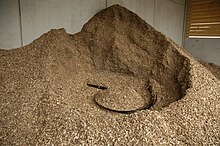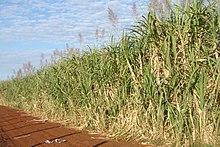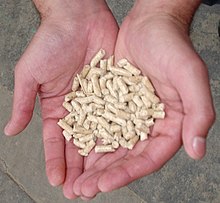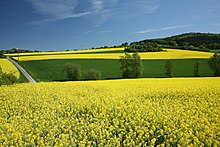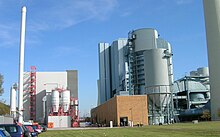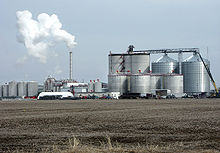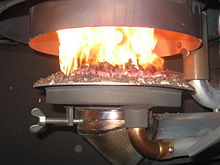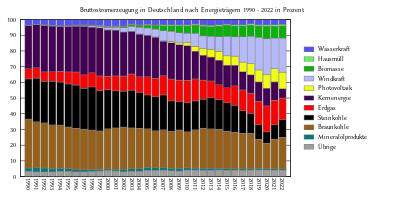Bioenergy

Bioenergy is one of biomass by conversion into electrical energy , heat or fuel universally usable form of energy . It uses biogenic fuels (or biofuels for short ), i.e. fuels of biological and organic origin. Biofuels store solar radiation energy in their chemical bonds , which was fixed by the plants as primary producers through photosynthesis . This energy can be released again through oxidation of these fuels, usually through combustion .
Traditionally, the renewable raw material wood has the greatest importance as an energy carrier . In addition, agriculturally produced agricultural raw materials and organic residues from different areas are used. The production and use of bioenergy sources is being expanded worldwide. Important reasons are, on the one hand, rising prices for fossil fuels over the long term , particularly due to their decreasing availability. On the other hand, the aim is to reduce the dependency on individual energy sources, such as crude oil and natural gas. Climate protection policy measures aimed at counteracting climate change are becoming increasingly important . Above all, this includes efforts to reduce greenhouse gas emissions . Furthermore, bioenergy can play a role as a CO 2 sink through CO 2 capture and storage in the context of the climate crisis . In Germany, the expansion of bioenergy is being promoted, for example with the Renewable Energy Sources Act (EEG).
The bioenergy debate includes technological , ethical and cultural issues. Effects on the environment such as soil, water, air, biodiversity , climate and fellow human beings are taken into account. Cultural aspects refer to cultivated landscapes or the traditional use of certain plant species as staple food . In many cultures, grain has a high symbolic content. Therefore, the energetic use of wheat is sometimes perceived as crossing ethical boundaries and is therefore often taboo .
Production of biogenic fuels
Almost all types of biomass can be developed for use as biogenic fuel. The fuel can be the main product, a by-product or a by- product . Depending on the type of biomass, different processing steps are necessary. Processes such as methane fermentation ( biogas ), alcoholic fermentation ( ethanol ), pyrolysis or oil extraction ( vegetable oil ) with subsequent transesterification ( biodiesel ) may be necessary, or, as with wood, they can also be used directly. It is mostly used in systems that are operated in an identical or similar form with fossil fuels, such as B. Firing with steam boiler , combustion engine , gas turbine .
- untargeted forest production
- One of the most important uses for biogenic fuels is the use of firewood for cooking and heating. This is usually not generated specifically, but collected in primary or secondary forests or in some other way.
- forestry production
- In commercial forests, timber (construction timber, veneer wood, etc.) is primarily produced. This also results in dead and small wood as well as inferior wood that can be used as firewood or for the production of wood pellets or wood chips .
- forestry by-products
- Examples of this are large quantities of sawdust and residual wood from the wood industry , which are used directly for thermal purposes or processed into pellets . In the paper industry , large amounts of lignin are produced when pulp is extracted from wood (mainly consisting of lignocellulose ) . This can be burned. In many processing processes, organic residues arise that can be used to produce biogas through incineration or fermentation .
- agricultural cultivation
- Due to the agricultural production of annual plants, biogenic fuels and the raw materials necessary for their production are the main product. Examples of this are oil plants for vegetable oil and biodiesel, starch plants and sugar plants, for example for the production of bioethanol, or so-called energy plants as a substrate for the production of biogas in biogas plants . Agricultural by-products that can be used for energy as waste are, for example, cereal straw (see also straw pellets ) and sugar beet leaves. In the future, straw from grain maize, rape and other crops, which has not been used until now, will be added (see residual value pellets ).
- agricultural production of perennial plants
- Separately used areas play an important role here, for example plantations for oil palm and oil fruits. Fast-growing plants such as miscanthus can also be grown for several years. The harvest takes place annually for this. Fast-growing tree species, such as certain types of willow and poplar , can be grown on the same area for many years and are harvested every year. The ability to erupt the cane saves having to re-plant the plants. By-products from processing are used directly as fuel or fuel pellets are produced from them, for example from olive pits and pressed olive pomace, coconut shells and oil palm kernels. The extraction of sugar from sugar cane leaves bagasse that can be used for energy purposes .
- organic waste
- Residual materials from industry and households can reduce or offset the disposal costs through energetic use. Bio-waste can be treated by composting , but it can also be used for energy purposes by fermentation to generate biogas . Sewage sludge usually contains a high proportion of organic compounds and is already used energetically through incineration, also to reduce the volume of the sewage sludge to be landfilled. The same applies to household waste , which in addition to components of fossil origin also contains a proportion of organic substances that is used by incineration. If household waste is dumped, anaerobic degradation can result in high- energy landfill gas from the organic components . Ultimately, landscape maintenance material made from tree and grass clippings by incineration or fermentation to form biogas (here mostly by dry fermentation ) can also be used as biogenic fuel.
- separately collected waste wood
- Waste wood from industrial waste wood , construction waste , from manual processing and from waste collection also serves as biogenic fuel.
- Others
- Peat is used as fuel unprocessed or pressed into pellets. Oil and animal meal also serve as biogenic fuel.
Categories of biogenic fuels
Biogenic fuels will according to their physical state divided.
Solid biofuels
Many biogenic solid fuels can be used without complex processing (just drying , shredding), such as wood ( logs , wood chips ), straw or bagasse. In some cases, these raw materials are also processed in a complex process in order to obtain products with more precisely defined properties (dimensions, energy content, ash content), such as wood and straw pellets. In many countries, solid fuels are important for providing heat for cooking. In Germany, solid fuels are used in small systems primarily to provide heat and in large systems to provide combined heat and power .
With the conversion of biogenic solid fuels into biomass to liquid (BtL), bio pyrolysis oil , synthetic natural gas (SNG), bioethanol , biogas and other products, there is the possibility of conversion into other aggregate states. Thermal, biochemical or other processes are used. Plant oils can be obtained from plant seeds (rapeseed, soy, sunflower) by pressing or extracting .
Biogenic liquid fuels
The most important biogenic liquid fuels are biofuels such as bioethanol, vegetable oil and biodiesel. These are mostly used in vehicle engines and must meet certain standardized properties. There are also other, less precisely defined biogenic liquid fuels such as pyrolysis oil , which is obtained from solid biomass.
Biogenic fuel gases
The biogenic fuel gases include digester gases (biogas, sewage gas, landfill gas), biomethane, SNG ( synthetic natural gas ) and bio-hydrogen. The latter two have so far had no economic significance in Germany. Biogenic fuel gases are primarily used for the combined supply of electricity and heat in combined heat and power plants (CHP), mostly at the gas production site: biogas plants, landfills, sewage treatment plants. After so-called biogas processing (especially the separation of carbon dioxide), biomethane can also be fed into the natural gas network. Digester gas is obtained by fermenting organic matter (e.g. liquid manure, silage , organic components in wastewater and household waste). SNG and bio-hydrogen can be produced by gasifying biomass to synthesis gas and subsequent processes to increase the methane content (CH 4 - in the case of SNG production) or the hydrogen content (H 2 - in the case of bio-hydrogen production).
Use of bioenergy
Biogenic heat and power generation

Various principles of energy conversion are used in energy technology systems for the use of biomass. For larger plant sizes, combined generation by means of combined heat and power (CHP) is common, which achieves a higher exergetic efficiency than with the sole generation of heat or electricity. Examples of CHP systems are biomass cogeneration plants (burning solid biofuels), biogas plants with combined heat and power units (CHP) and biomass gasifiers with CHP (wood gas CHP).
- Biomass power plants are year-round operated systems for biomass combustion that produce electricity via steam turbines . The electrical efficiency is between 30 and 35 percent. Used wood (scrap wood ) and other inexpensive wood segments ( residual wood ) are mainly used . The typical electrical output is 20 MW.
- Biomass cogeneration plants use biomass all year round to generate heat and electricity. Steam turbines and ORC turbines are mostly used here. In addition to forest wood ( residual forest wood ) and industrial waste wood as the main fuel, agricultural products such as wood from short rotation plantations and straw can also be used. In Scandinavia (especially Finland ), peat is often added to the fire because it is obtained locally. The electrical efficiency is 15 to 25 percent, the thermal efficiency around 60 percent. The typical electrical output is 0.5 to 50 MW.
- Biomass heating plants or pellet boilers generate useful heat. In larger heating plants, cheaper wood chips are usually used, in smaller plants pellets, which have better defined properties as fuel and are therefore less demanding in terms of conveyor technology and require less maintenance. Use in small systems (chimneys, stoves, boilers) in residential buildings is possible, for example in pellet heating systems or log boilers . Wood chip heating systems are used when there is a higher heat requirement (apartment buildings, commercial, industrial) .
- Biomass gasifier CHP (wood gas CHP) are currently still in development and market launch. They are based on the combustion of process gases that arise during biomass gasification . Different assortments of wood, stalk-like biomass and many other raw materials can be used. The electrical efficiency is 10 to 30 percent, the thermal efficiency around 40 to 50 percent. The typical electrical output is between 30 and 250 kW.
- So-called biogas is produced through fermentation of liquid manure , plant silage and other biomass ( substrate ) in biogas plants . In most cases, the gas is first slightly processed and then electrical power and useful heat are generated in a CHP near the biogas plant. In Germany, according to the Gas Network Access Ordinance (GasnetzZugVO), it is also possible to feed into the natural gas network through a further, more complex processing ( biogas processing ) to biomethane . By converting the biomethane into electricity at a suitable heat sink , a better use of waste heat can be possible. It is also possible to use the biomethane as a fuel in vehicles with natural gas drives .
- Another option can be the production of synthetic natural gas (SNG, synthetic natural gas) from biomass by pyrolysis and subsequent methanation . As with the upgrading of biogas to biomethane in natural gas quality, this product of a methanation process can also be upgraded to natural gas quality and fed into the natural gas network. As with natural gas, it can also be used to generate electricity and heat as well as fuel. So far, the generation of SNG has only played a minor role. The production of hydrogen from biomass appears to be more promising, since the thermo-chemical production process is not more complex, but the climatic advantage is higher due to the early carbon separation. The latter is particularly the case when biochar is produced and plowed into fields to improve soil fertility.
Biofuels
Biofuels are used in internal combustion engines such as internal combustion engines or gas turbines .
They are often divided into a first, second, and third generation. However, this classification is problematic as there are neither clear delimitations nor generally accepted definitions of the respective generation.
- First generation biofuels
Conventional biofuels such as bio-ethanol made from grain and bio-diesel made from rapeseed only use the plant fruit and are often referred to as the "first generation".
- Bioethanol is fermentation of sugars (from sugar beet , sugar cane ) and sugar polymers as mainly starch (from maize , corn , potato ) won.
- Vegetable oils are obtained by pressing or extraction from oil-containing plant components (fruit of rapeseed , soy , sunflower ).
- Biodiesel is produced from vegetable oils by transesterification to improve its properties as a fuel .
- Second generation biofuels
Second generation biofuels - such as cellulosic ethanol or synthetic biodiesel - allow the whole plant to be used and thus have greater sustainability advantages. In addition, they can use straw and vegetable residues and do not interfere with the food chain like first-generation biofuels. In particular, cellulose and lignocellulose components of plants and wood are assigned a high potential. However, since the production process is significantly more complex with the current state of the art than with fuels of the first generation, no implementation has been carried out on a large commercial scale to date.
- BtL ( biomass to liquid ) can be made of almost any kind of biomass ( straw , miscanthus , short rotation wood , wood residues are produced, wood waste). This is first broken down into low molecular weight components by gasification and then converted into a mixture of hydrocarbons after a gas purification by Fischer-Tropsch synthesis . The procedures are still under development.
- Biomethane from biogas can also be used as fuel.
- The production of bioethanol from cellulose ( cellulose-ethanol ) is also still in development.
- Third generation biofuels

Occasionally, algae fuels are mentioned as the third generation of biofuels due to the high productivity of the algae per cultivation area. However, there is currently no commercial production and is not expected by experts in the foreseeable future due to high operating and investment costs. However, there are plans to use seaweed for energy in the form of biogas or biofuels . A pilot project for this started in 2013 on the Fiji Islands , whose coasts are often affected by algal blooms . The removal of the algae washed up on the beaches has so far been associated with a great deal of effort. In the long term, according to a study published in 2012, algae plantations in the sea could cover all of mankind's fossil energy needs and - assuming the use of carbon dioxide capture - simultaneously reduce the CO 2 content in the earth's atmosphere .
Potential and space requirements
The potential of bioenergies depends primarily on the availability of cultivation areas on which renewable raw materials (NawaRos) can be grown for energy generation. The amount of agricultural, forestry and other organic residues is also important.
Worldwide
The energetic potential of bioenergy is controversial worldwide. In 2006 the International Energy Agency came to the conclusion that assuming very rapid technological development, up to 700 exajoules (EJ) of bioenergy could be used worldwide without endangering food production, forests or biodiversity. This means that bioenergy would have the potential to cover around 60% of the estimated primary energy demand in 2050. More recent studies indicate the potential more conservatively at 180 EJ, which corresponds to about 15% of the energy demand expected for 2050.
According to surveys by the Food and Agriculture Organization (FAO), 3.5 billion hectares of degraded land can be used for the cultivation of bioenergy crops. In contrast, the cultivation area for biofuels in 2007 was only 30 million hectares worldwide. According to this, the potential for bioenergy available worldwide would still be largely untapped, which would result in hardly any competition with food cultivation.
According to a report by the German Advisory Council on Global Change (WBGU), the technical potential , taking into account very far-reaching nature conservation criteria, is between 30 EJ and 120 EJ, which corresponds to about 6 to 25 percent of the primary world energy demand . Together with biogenic residues, bioenergy can provide 80 to 170 EJ and thus 16 to 35 percent of the world's energy needs. Due to economic and political restrictions, however, only around half of the potential can be siphoned off (8 to 17.5 percent of world energy demand).
Other studies calculate far higher possible potentials up to 1440 EJ (three times the world energy demand). The basis is in particular higher assumptions about the yield per unit area, especially on degraded soils . These were assessed conservatively in the WBGU report. A study commissioned by the Renewable Energy Agency comes to the conclusion that if half of the world's degraded areas are used, more than 40 percent of today's global primary energy demand can be covered by energy crops. Together with biogenic residues, half of the world's total energy demand can therefore be met with the help of bioenergy, without having to compete with nature conservation or food supply.
Three percent of the world's agricultural area is used for growing bioenergy, or six percent of the world's grain harvest. The proportion of arable land required has remained constant in recent years with a simultaneous increase in biofuel production.
Europe
With regard to the bioenergy potential in the EU-27, studies show a range of 5 to 14 exajoules per year, of which 2 to 7 exajoules on energy crops and 1 to 7 exajoules on forest growth. This corresponds to 6% to 20% of the current EU primary energy consumption.
Currently, six percent of the global grain harvest is used to produce bioenergy for fuel, electricity and heat generation. 3.2 percent of the European grain harvest is used for bioenergy. The majority (58 percent) is used for animal feed.
The multi-year European research project “Biomass Futures” has determined that by 2020 more than 21 million hectares in the EU could be free for the cultivation of energy crops. The 4FCrops research project calculates a similar result with around 20 million hectares of potential land, despite other assumptions. Currently (beginning of 2014) the EU has an expansion target of 10% biofuels by 2020. This can be exceeded based on the areas available in the EU.
Germany
The energetically usable biomass potential in Germany is estimated at around 1200 PJ, which corresponds to around 9% of the German primary energy demand in 2011.
In 2009, 1.7 million hectares were grown on ten percent of the arable land. According to a material flow analysis presented by the Federal Environment Ministry, this area can more than double by 2020 (4 million ha) without competing with food production . The energy crops produced on this area can, together with biogenic residues, provide around 16 percent of Germany's electricity demand , 10 percent of the heat demand and 12 percent of the fuel demand. A potential atlas presented in 2013 determines the biomass potential of the individual federal states.
According to the Renewable Energy Potential Atlas presented by the Renewable Energy Agency in January 2010, the land requirement for bioenergy will increase from 1.6 million hectares today to 3.7 million hectares in 2020, with 15 percent of the total German electricity, Heat and fuel requirements can be covered by bioenergy. The supply of food is never endangered. "Despite the increasing share of bioenergy, there are significant surpluses in the grain harvest in Germany and the EU every year," says Daniela Thrän from the German Biomass Research Center (DBFZ) . “The productivity in agriculture continues to rise on average. In addition, there are residual materials such as straw, liquid manure or residual wood as well as fallow land - so the potential in bioenergy is still very large ”.
According to scientists, sustainably produced biofuels can play an important role in the energy mix of the future. In ambitious climate protection scenarios, around 20 percent by 2030 and around 70 percent by 2050 of a significantly reduced fuel requirement for all modes of transport in Germany could be met sustainably and without competition for use or additional imports. This means that biofuels come either from residues or from production on land that has been vacated over the long term, do not have a negative impact on biodiversity, do not reduce Germany's level of self-sufficiency in food, and no meadow or pasture is converted. Worldwide, biofuel demand could even increase tenfold between 2010 and 2050.
Significance in Germany
Share in the energy supply
Around 70% of the renewable energies used in Germany in 2008 came from bioenergy and thus from biogenic fuels. It thus accounts for around 6.7% (15.6 TWh ) of Germany's final energy demand (233 TWh). The provision of heat accounted for around 60% of bioenergy, and the provision of fuel and electricity around 23 and 17%, respectively.
Promotion of biogenic fuels
The use of biogenic fuels is encouraged for several reasons. So z. For example, the climate can be protected by lower greenhouse gas emissions , fossil resources conserved and the dependence on countries with large raw material deposits (e.g. crude oil, natural gas) reduced. With the Renewable Energy Sources Act (EEG), electricity generation from renewable energies such as biogenic fuels is promoted. The Biofuel Quota Act (BioKraftQuG) defines a minimum amount of biofuels to be added to conventional fuels. The Renewable Energies Heat Act (EEWärmeG) promotes heat supply through bioenergy, among other things. Similar laws based on the Renewable Energy Sources Directive (EC) ( EU Directive ) also apply in the other EU countries.
Evaluation of bioenergies
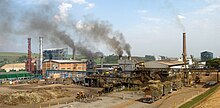
When evaluating bioenergies, numerous aspects have to be taken into account, such as economic efficiency, climate compatibility , the impact on ecology ( biodiversity ) and the competition for land compared to food production. Since these aspects are often in contradiction to one another, the assessment usually leads to ambivalent results. In addition, no uniform assessment is possible for all bioenergies, as the individual energies differ greatly in terms of provision, use, efficiency, emissions, etc.
advantages
- An important advantage of bioenergies is based on their renewability . Deposits of fossil fuels are spared.
- Bioenergies can help reduce greenhouse gas emissions. When biomass is burned, only as much carbon dioxide is released as was previously absorbed from the atmosphere during photosynthesis. (Disadvantage: In the case of bioenergies, it must be taken into account that the generation and use of biomass can result in emissions of strong greenhouse gases ( laughing gas , methane ), which can lead to a negative climate balance .)
- The increased use of biofuels can reduce dependency on energy raw material imports and avoid conflicts. Developing countries in particular spend a large proportion of their financial resources on importing energy sources such as crude oil .
- In contrast to wind energy and solar energy, biomass power plants and biogas plants, which are used to generate electricity, have a base load capacity and their output can be regulated, so that they represent a good complement to the volatile renewable energies mentioned. According to the Federal Environment Ministry, the installed electrical output of all biomass plants in Germany (solid and liquid fuels, biogas, biogenic part of waste) was around 6,800 MW in 2011 , corresponding to around 5 nuclear power plants with an output of 1,300 MW.
- Bioenergy can make an important contribution to strengthening rural areas and curbing rural exodus, for example by regenerating degraded areas around the world, opening up a second mainstay for farmers through their own production of electricity, heat and fuels, and providing a decentralized energy supply .
- The use of biomass such as B. Forest wood is CO 2 -neutral if no more wood is removed from the forest than grows back at the same time.
- Above all, bioenergy is given a very good ecological balance if organic waste, residues and organically polluted wastewater are recycled, which would otherwise have to be treated with potentially great amounts of energy. Since such residual and waste materials are available inexpensively or free of charge, they can be used economically. This takes place, for example, in sewage treatment plants and biogas plants with cofermentation. In countries such as China and India, micro biogas plants that run on organic waste and supply individual households with cooking gas are widespread. The recycling of liquid manure is rated as more problematic from a life cycle perspective.
- Monocultures of energy crops can be avoided by cultivation systems such as mixed crop cultivation (simultaneous cultivation of energy crops such as maize and sunflowers) or two-crop systems (cultivation of winter and summer crops on the same area, e.g. winter triticale and sugar millet ) and at the same time secure sustainable high yields. Some plants, such as rapeseed, cannot be grown more than once in one area, which also limits the extent of monocultures.
disadvantage
- The area efficiency ( power density ) is less than 0.5 watt per square meter, i.e. H. less than a tenth that of photovoltaic systems . Even cultivating the entire German land area with energy crops would not be able to cover Germany's primary energy needs.
- The greenhouse gas emissions are very high for renewable energies at approx. 230 g / kWh (see photovoltaics: 41 g / kWh, natural gas power generation (non-renewable): 490 g / kWh).
- The cultivation of arable land with energy crops leads to competition for land for food and feed production. The increased demand for corn for the production of ethanol fuel is discussed as one of the possible causes of the food price crisis 2007-2008 . see main article food competition
- If biofuels are grown in intensive agriculture, this leads to environmental pollution. As a rule, pesticides and mineral fertilizers are used, which can lead to water and groundwater pollution and their production is also very energy-intensive. Nitrogen fertilizers can lead to increased emissions of the greenhouse gas nitrous oxide. That is why the carbon footprint of biofuels is controversial among scientists. According to statements by well-known scientists, including Nobel Prize winner Paul J. Crutzen , the allegedly positive climate balance does not apply.
- The rapidly increasing cultivation of only a few types of energy crops , such as primarily rapeseed and maize in Germany, is changing the landscape. This was reinforced by the abolition of set-aside in the European Union. This can also threaten biodiversity .
- The conversion of ecologically valuable areas such as rainforest , bog or grassland into arable land also leads to a threat to and reduction of biodiversity. In addition, these areas can have stored large amounts of CO 2 in their original state , which is released when it is converted into arable land ( slash and burn , drainage). The Sustainability Ordinance aims to ensure that the biomass used for biofuels in this country does not come from overexploitation of rainforests. Furthermore, when fallow land is converted into arable land, considerable amounts of climate-damaging gases (methane, nitrogen oxide) are released, so that the climate balance is negative for many years.
- Some of the biomass must remain on agricultural land in order to maintain the soil quality. The humus balance deteriorates through the full use of the plants. In the case of forest biomass, intensive use leads to the withdrawal of nutrients from the forest. In addition, dead wood provides a habitat for many different species.
- Since many bioenergy sources are flammable, there is a risk of fire as well as explosion .
Statutory sustainability criteria
With the Biomass Electricity Sustainability Ordinance and the Biofuel Sustainability Ordinance, it is legally ensured that ecological sustainability standards are complied with for biofuel production and for the production of liquid bioenergy sources for electricity generation (including no clearing of rainforests, positive climate balance, etc.). The fulfillment of these criteria must be proven by a certification system. Various points of criticism are expressed, such as enforcement problems especially in developing countries, incompleteness, problems such as competition for use with food production cannot be formulated as criteria and there is a risk of relocation effects that let the criteria run dry Result in rainforest.
The sustainability certification obliges the marketers to demonstrate a greenhouse gas reduction of at least 35% compared to fossil fuels (from 2017: 50%), taking into account the entire production chain. According to surveys by the Federal Office for Agriculture and Food , the average greenhouse gas savings from German biofuels are around 44% compared to fossil diesel, which significantly exceeds EU standards. In 2011, around five million tons of CO 2 were avoided as a result.
The director of the Federal Environment Agency, Jochen Flasbarth, explained: "If the demands placed on all agricultural uses were as high as those placed on biofuel, then we would live in a better world."
Bioenergy perspective
A further expansion of bioenergy is to be expected in the future. In Germany, funding takes place through various measures. The Renewable Energy Sources Act (EEG) ensures, among other things, increased remuneration for electricity from biomass, but also promotes combined heat and power (CHP). According to the Energy Tax Act , pure biofuels are also tax-privileged. Bioenergies are also promoted in other countries (Austria, Sweden, USA etc.) and in some cases cover a large proportion of the energy demand. Since bioenergy, unlike wind and solar power, is easy to store, it is seen as an important control energy for future power supply ( virtual power plant ). Due to the higher investment and maintenance costs compared to fossil fuels, competitiveness is not always given. This can also benefit from the low energy prices for oil and gas.
Over 120,000 jobs have been created in the bioenergy sector, which corresponds to around a third of all jobs in the renewable energy sector. In addition to growth areas such as biogas, there have also been slumps, such as the closure of many small oil mills as a result of biofuel taxation at the expense of regional value creation.
Scientists propose using bioenergy for the combined generation of electricity and heat (combined heat and power) instead of for fuel. This is much more efficient. In addition, energy consumption is to be reduced through greater efficiency and sustainable lifestyles.
literature
- National Academy of Sciences Leopoldina : Bioenergy: Possibilities and Limits. Supplemented version of the study Bioenergy - Chances and limits Halle (Saale) published in 2012 .
- Michael Zichy, Christian Dürnberger, Beate Formowitz, Anne Uhl: Energy from biomass. An ethical discussion model. 2nd updated edition. Springer Vieweg, Wiesbaden 2014
- Martin Kaltschmitt , Hans Hartmann, Hermann Hofbauer (Hrsg.): Energy from biomass. Basics, techniques and procedures , Berlin / Heidelberg 2009, ISBN 978-3-540-85094-6 .
- Renewable Energy Agency: Bioenergy: Diversity in the Foreground , Brochure, PDF, 7 MB
- Martin Kaltschmitt, Wolfgang Streicher, Andreas Wiese (eds.): Renewable energies. System technology, economy, environmental aspects . Springer Vieweg, Berlin / Heidelberg 2013, ISBN 978-3-642-03248-6 .
- Wolfgang Gründinger : Bioenergy as a way out of the ecological, financial and socio-political crisis - Speech at the 4th BBE symposium for bioenergy and sustainability: "Secure acceptance through sustainable use of bioenergy!" (PDF; 84 kB), 6 July 2011 , Düsseldorf
- Uwe R. Fritsche u. a .: Sustainable bioenergy: final summary report. (PDF; 1.4 MB) Öko-Institut , Darmstadt 2010 (final report on the research project “Development of strategies and sustainability standards for the certification of biomass for international trade”, in cooperation with IFEU Heidelberg , on behalf of the Federal Environment Agency).
- Institute for Agricultural Policy at the University of Giessen: Determining factors for the level and volatility of agricultural commodity prices on international markets. Implications for world food and policy making (PDF; 3.4 MB), University of Gießen, 2012
- Scientific Advisory Council of the Federal Government on Global Change (Hrsg.): Welt im Wandel. Sustainable bioenergy and sustainable land use. (PDF; 25.3 MB) WBGU, Berlin 2008, ISBN 978-3-936191-21-9 , (annual report).
- Scientific Advisory Board of the Federal Government on Global Change (Ed.): Factsheet 1/2009 Bioenergy. WBGU, Berlin 2009.
- Uwe R. Fritsche, Kirsten Wiegmann: Greenhouse gas balances and cumulative primary energy consumption of bioenergy conversion paths, taking into account possible changes in land use. WBGU, Berlin 2008 (Expertise of the Öko-Institut on the WBGU report 2008).
- Food and Agriculture Organization of the United Nations (Ed.): The State of Agriculture. Biofuels: prospects, risks and opportunities. FAO, Rome 2008, ISBN 978-92-5-105980-7 .
- Ludger Eltrop, Konrad Raab, Institute for Energy Economics and Rational Use of Energy (ed.): Guide to Bioenergy. Planning, operation and profitability of bioenergy plants. 2nd Edition. Agency for renewable raw materials , Gülzow 2005, ISBN 3-00-015389-6
- German Association for Landscape Management, Naturschutzbund NABU (Ed.): Bioenergy - but of course! Renewable raw materials from the point of view of environmental and nature conservation. (PDF; 5.6 MB) Berlin 2007.
- Martin Kaltschmitt, Wolfgang Streicher, Andreas Wiese (eds.): Renewable energies. System technology, economy, environmental aspects . Springer Vieweg, Berlin / Heidelberg 2013, ISBN 978-3-642-03248-6 .
- Fachagentur Nachwachsende Rohstoffe e. V. (FNR): Guide to Bioenergy - Planning, Operation and Economic Efficiency of Bioenergy Plants - Focus on Biogenic Solid Fuels , Gülzow 2005, 2nd revised edition, ISBN 3000153896 , as an online version
Web links
| Renewable energy |
|---|
General portals
- Renewable Energy Agency, "Biomass" portal
- Public information portal for renewable energies, article "Bioenergy"
- Agency for Renewable Resources (FNR)
- Promotion company for sustainable biogas and bioenergy use
Interest groups
Bioenergy research
Bioenergy projects
- Institute for Bioenergy Villages Göttingen
- Practical examples for bioenergy systems on the website of the Lower Saxony Network for Renewable Raw Materials (3N), accessed on January 20, 2010
Individual evidence
- ↑ Michael Zichy, Christian Dürnberger, Beate Formowitz, Anne Uhl: Energy from biomass. An ethical discussion model. 2nd updated edition. Springer Vieweg, Wiesbaden 2014, 69ff.
- ↑ Fuel, especially in the form of pellets, made from olive residues and combustible organic and / or inorganic substances , German patent DE102007031277A1, issued from January 8, 2009.
- ↑ olivenpellets.de .
- ↑ Manufacturer of pellets made from tropical wood, coconut shells and oil palm kernels .
- ↑ A pipe dream or a good idea: Researchers want to save the world with algae . In: Wirtschaftswoche , September 3, 2013. Retrieved September 11, 2013.
- ↑ Antoine de Ramon N'Yeurt, David P. Chynoweth, Mark E. Capron, Jim R. Stewart, Mohammed A. Hasan, Negative Carbon via Ocean Afforestation , in: Process Safety and Environmental Protection 90 (2012), p. 467– 474, online (PDF; 536 kB).
- ↑ Cf. Viktor Wesselak , Thomas Schabbach , Thomas Link, Joachim Fischer: Handbuch Regenerative Energietechnik , Berlin / Heidelberg 2017, p. 171.
- ↑ Jürgen O. Metzger, Aloys Hüttermann: Sustainable global energy supply based on lignocellulosic biomass from afforestation of degraded areas. In: Natural Sciences. 96, No. 2, 2009, doi : 10.1007 / s00114-008-0479-4 .
- ^ Scientific Advisory Board of the Federal Government on Global Change (WBGU): World in Transition: Sustainable Bioenergy and Sustainable Land Use. ( Memento from January 9, 2017 in the Internet Archive ) Berlin 2009.
- ^ Agency for Renewable Energies (Ed.): Global Bioenergy Use - Potentials and Usage Paths. ( Memento from June 3, 2013 in the Internet Archive ) (PDF; 939 kB) Berlin 2009, p. 9.
- ↑ Estimates of the German Farmers' Association, January 2012 ( Memento from February 28, 2012 in the Internet Archive )
- ↑ FAO Food Outlook 2014
- ↑ Research radar Energiewende: Meta-analysis potentials of bioenergy ( Memento of February 18, 2015 in the Internet Archive ), p. 7
- ↑ BMELV: The full overview in matters of bioenergy, 2011, p. 6 ( Memento of April 8, 2014 in the Internet Archive )
- ^ Agency for Renewable Energies, background paper "Biofuels", 2012, p. 9 ( Memento from May 20, 2012 in the Internet Archive ) (PDF; 1.8 MB)
- ↑ Alterra / IIASA: Atlas of EU biomass potentials. Download ( Memento from May 6, 2014 in the Internet Archive ) (PDF)
- ↑ EU research project 4FCrops ( Memento from July 5, 2015 in the Internet Archive )
- ↑ Volker Quaschning : Regenerative Energy Systems. Technology - calculation - simulation . 9th updated edition. Munich 2015, p. 366.
- ↑ Agency for Renewable Energies (ed.): The full overview in matters of bioenergy. ( Memento from May 16, 2011 in the Internet Archive ) Berlin 2009, p. 10.
- ↑ Bioenergy potential atlas in the federal states
- ↑ A lot of income in a small area - first renewable energy potential atlas published.
- ↑ Study by the Institute for Sustainability Analyzes and Strategies (IINAS) and the Institute for Energy and Environmental Research Heidelberg GmbH (ifeu) on behalf of Shell, 2012
- ↑ Biofuels - Basic Data Germany , as of October 2009 Fachagentur Nachwachsende Rohstoffe e. V. (FNR), Gülzow, 2009, 14-page brochure, available as pdf.
- ↑ cf. also background paper: Critique of biofuels in the fact check (October 2013)
- ↑ Time series on the development of renewable energies in Germany ( Memento from July 27, 2011 in the Internet Archive ) (PDF; 344 kB). Website of the Federal Ministry for the Environment, Nature Conservation and Nuclear Safety . Retrieved July 31, 2012, Tab. 3.
- ↑ Valentin Crastan , Electrical Energy Supply 2 , Berlin Heidelberg 2012, p. 58.
- ↑ Walter Edelmann u. a: Ecological, energetic and economic comparison of fermentation, composting and incineration of solid biogenic waste. ( Memento of April 8, 2014 in the Internet Archive ) (PDF; 3.4 MB) February 2001.
- ↑ Partly different in: Advisory Council for Environmental Issues (Ed.): Climate protection through biomass. Schmidt, Berlin 2007, ISBN 978-3-503-10602-8
- ↑ Dieter Deublein, Angelika Steinhauser (Ed.): Biogas from Waste and Renewable Resources. Wiley-VCH, Weinheim 2008, ISBN 978-3-527-31841-4 .
- ↑ Werner Edelmann u. a .: Ecological balance of electricity generation from agricultural biogas. ( Memento of April 8, 2014 in the Internet Archive ) (PDF; 3.7 MB) Bioenergy Working Group, Baar 2001.
- ↑ Kathrin Deiglmayr: Biogas crop rotations - ecologically sustainable and economically successful. ( Memento from December 14, 2010 in the Internet Archive ) Straubing 2009.
- ^ National Academy of Sciences Leopoldina (ed.): Bioenergy - possibilities and limits . Halle (Saale), Germany 2013, p. 23 ( leopoldina.org [PDF]).
- Jump up ↑ Schlömer S., T. Bruckner, L. Fulton, E. Hertwich, A. McKinnon, D. Perczyk, J. Roy, R. Schaeffer, R. Sims, P. Smith, R. Wiser: Annex III: Technology- specific cost and performance parameters . In: Climate Change 2014: Mitigation of Climate Change. Contribution of Working Group III to the Fifth Assessment Report of the Intergovernmental Panel on Climate Change . Cambridge University Press, Cambridge, United Kingdom / New York, NY, USA 2014, pp. 1335 (English, ipcc.ch [PDF]).
- ↑ N2O release from agro-biofuel production negates global warming reduction by replacing fossil fuels, PJ Crutzen, AR Mosier, KA Smith, and W. Winiwarter, Atmos. Chem. Phys. Discuss., 7, 11191-11205 Abstract
- ↑ Federal Ministry of Food, Agriculture and Consumer Protection (Ed.): Expert opinion of the Scientific Advisory Board on Agricultural Policy "Use of biomass for energy production - Recommendations for politics". (PDF; 1.7 MB) Report of the Advisory Council for Agricultural Policy, November 2007
- ↑ Renews Compact: Indirect Land Use Change - Problem or Illusion? 2012
- ↑ Luzerner Zeitung: How dangerous are bio-power plants? It burned twice in biofuel plants within two months. The fire brigade in particular was in great danger . November 6, 2012. Online at luzernerzeitung.ch. Retrieved December 22, 2018.
- ↑ Biofuel Sustainability Ordinance
- ↑ Biomass electricity sustainability ordinance
- ↑ Grit Ludwig: Sustainability requirements for the cultivation of renewable raw materials in European law. In: Journal for Environmental Law. No. 6, 2009, pp. 317-322.
- ↑ Press release Agency for Renewable Energy, June 22, 2012 ( Memento of July 27, 2012 in the Internet Archive )
- ↑ Tagesspiegel, March 7, 2011; see. also Renews Compact Oct. 2013 , p. 8
- ↑ Frank Stocker: That is why the low oil price is so dangerous . In: THE WORLD . December 14, 2015 ( welt.de [accessed December 26, 2018]).
- ↑ Press release Agency for Renewable Energies ( Memento of May 8, 2012 in the Internet Archive )
- ^ Felix Ekardt, Mareike Heering, Andrea Schmeichel: European and national regulation of bioenergy and its ecological-social ambivalences. (PDF; 119 kB) In: Nature and Law. 31, No. 4, 2009, pp. 222-232, doi : 10.1007 / s10357-009-1649-7 .
- ^ Expert Council for Environmental Issues (ed.): Climate protection through biomass. Schmidt, Berlin 2007, ISBN 978-3-503-10602-8
